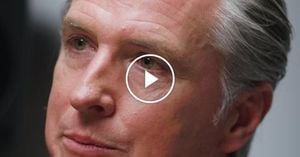The U.S. economy has once again landed in the spotlight, leaving experts, policymakers, and everyday Americans scratching their heads over what to make of the latest jobs report and the broader signals coming from Wall Street and Main Street alike. On November 20, 2025, after a seven-week delay caused by a government shutdown, the U.S. Labor Department finally released the September jobs report. The numbers were, in a word, confusing.
According to CNN and The Fiscal Times, U.S. employers added 119,000 jobs in September 2025—a figure that more than doubled economists’ modest expectations of 50,000. It was also a sharp turnaround from August’s revised loss of 4,000 jobs. Yet, the good news was quickly tempered by a rise in the unemployment rate, which inched up by 0.1 percentage points to 4.4%. That’s the highest level seen in four years, driven in part by nearly half a million new entrants into the labor market, as reported by The Fiscal Times.
The underlying picture, however, is far from straightforward. Between May and August 2025, job gains averaged just 31,000 per month—about one-fifth the monthly rate seen the previous year, according to CNN. The September figure, while better than feared, did little to change the overall trend of a sluggish, uneven labor market. Heather Long, chief economist at Navy Federal Credit Union, told CNN, “I don’t know that anybody should be cheering about what we saw in the September jobs report. I think it’s a relief that it wasn’t worse and that it was (119,000) jobs added; but also remember, almost every number lately has been revised down.”
Even the sectors seeing growth reveal the patchy nature of the recovery. The Fiscal Times highlighted that job gains were concentrated in leisure and hospitality (+47,000), healthcare (+42,800), and construction (+19,000). On the flip side, federal employment shrank by 3,000 jobs, manufacturing lost 6,000, and transportation and warehousing took a significant hit with a loss of 25,300 jobs. Jed Kolko, a senior fellow at the Peterson Institute for International Economics, pointed out that average job growth in 2025 has been about 76,000 jobs per month, the lowest annual average this century outside of a recession.
The labor market’s mixed signals have not gone unnoticed by the Federal Reserve. Federal Reserve minutes released on November 19, 2025, showed deep skepticism about a December rate cut, as reported by CNN. Policymakers are caught between concerns about persistent inflation and a labor market that seems to be treading water. “The Fed probably won’t cut in December,” Long wrote on social media, “But it’s hard to argue things look better in the labor market. It’s still ‘no hire, no fire.’”
Market watchers are equally perplexed. After the jobs report and strong earnings from tech giant Nvidia, the Dow Jones Industrial Average soared by 700 points early on November 20, only to give up those gains and fall more than 200 points by midday, according to CNN. The Fiscal Times reported that market odds for a quarter-point rate cut in December rose to 39% from 30% after the jobs report, reflecting just how uncertain investors are about the path forward.
Meanwhile, the so-called K-shaped economy—the idea that some groups are faring much better than others—remains firmly in place. A Fox News poll cited by CNN found that 76% of Americans now have a negative view of the economy, up from 67% in July. Only 15% said President Trump’s policies are helping their financial situation, while 46% said they are hurting it. This widespread dissatisfaction is reflected in consumer behavior: Home Depot and Target posted disappointing earnings and cut forecasts, noting that shoppers are making fewer visits and spending less. Chipotle, Coca-Cola, and Crocs echoed these concerns, highlighting that households earning less than $100,000 are struggling with high prices and persistent inflation.
But not everyone is feeling the pinch. Walmart reported that its fastest-growing customer segment is people earning more than $100,000—consumers who are still spending, but increasingly on the hunt for value. As Heather Long told CNN, “People’s financial situations are getting squeezed. It’s harder to find work. And for people who have jobs, their income is not rising much faster than inflation. It’s this treading water feeling for the middle class right now, and that’s the part I don’t see changing.”
Against this backdrop, the stock market’s recent volatility has only added to the confusion. According to CNN, fears of an AI bubble rattled markets in late October when Palantir, a major AI contractor, issued a weaker-than-expected forecast. AI stocks, which had been the bedrock of market gains for years, started to slide. But Nvidia’s blockbuster earnings report on November 19 reversed those losses—at least temporarily—by showing that demand for its industry-leading AI chips remains robust.
Still, the disconnect between Wall Street and the real economy is hard to ignore. The Fiscal Times quoted U.S. Bank Chief Economist Beth Ann Bovino, who said, “The jobs market is still rather fragile, but this is one sign that maybe it’s not as ugly as markets had worried.” She attributed some of the September job growth to seasonal factors: “summer’s over, people leave the beaches and come back to work.”
For policymakers, the muddled data complicates an already tricky balancing act. The Trump administration, facing mounting public frustration, has floated a range of new policies—from lowering housing costs to sending stimulus checks and cutting tariffs. These proposals, as CNN noted, are controversial and have divided economists, but they reflect a growing sense of urgency to address what many see as an affordability crisis.
Meanwhile, the political temperature in Washington has only risen. President Trump’s recent social media posts, in which he accused Democratic lawmakers who urged military personnel to defy illegal orders of “seditious behavior, punishable by death,” have sparked outrage and calls for condemnation from both sides of the aisle. Senate Minority Leader Chuck Schumer said, “Let’s be crystal clear: the President of the United States is calling for the execution of elected officials. This is an outright threat, and it’s deadly serious.” The Democrats targeted by Trump responded in a joint statement: “We are veterans and national security professionals who love this country and swore an oath to protect and defend the Constitution of the United States. That oath lasts a lifetime, and we intend to keep it. No threat, intimidation, or call for violence will deter us from that sacred obligation.”
In the end, the September jobs report has done little to clear the economic fog. If anything, it’s deepened the sense of uncertainty. As Mike Reid, RBC’s senior U.S. economist, told CNN, “This morning’s employment report is adding more confusion than clarity to an exceedingly foggy backdrop.” For now, Americans will have to wait and see whether policymakers, business leaders, and the Federal Reserve can chart a course through the haze—and whether the next round of data will finally bring some clarity to the state of the nation’s economy.




